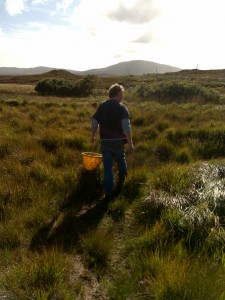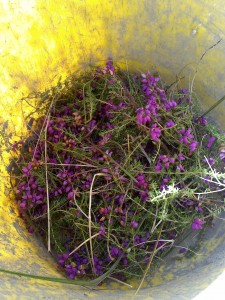Brew day stage one: Gathering the Heather
After a fruitless (flowerless!) Saturday afternoon drive with one year old in tow, up the Crumlin (‘crooked glen’) Valley near Cornamona, Co. Galway (or ‘Gleann gan Fraoch’ as we’ve taken to calling it), we finally came across a reasonable growth of Bell Heather south of Maumwee Lough near Lackavre (but not, we stress, within the SAC). Although we gathered insufficient for our new brew, we have a starter bucket of heather at least. A mid-week trip in search of more heather is in order prior to our brew day on Sunday. We had intended to gather solely Bell Heather, but we’ll supplement with the more plentiful ling. Once again, the Galway Hooker men have donated a bag of barley to us, but this time it’s unmilled. We’re still desperately seeking a barley crusher or milling machine locally – any suggestions more than welcome. It would save us a great deal of manual labour (although we are dedicated to the idea of producing an authentic ancient ale, we would prefer to stop short at grinding the malt ourselves).

Seasonal labourer Billy Quinn gathering heather
This years ale will be our very own ‘hot rock heather ale’ – for a commercially produced example see Bruce and Scott Williams’ Fraoch here. Fraoch is both the Irish and Scot’s Gaelic name for heather and the Williams Bros. Ale is a flowery ale which also incorporates bog myrtle. The Williams Bros. pick their heather in July and August as it flowers up through Scotland. They’ve now been brewing Fraoch for over 21 years and recently produced a 20th Anniversary Fraoch aged in Whisky casks.
We’ve mentioned heather ale here before, notably this blog post by Zythophile. Zythophile goes into great detail on the Irish origins of Heather Ale. He also recounts the details of a paper in the Ulster Journal which has provided us with our proposed recipe; a mixture of Bell and Ling Heather, Bog Myrtle and Tormentil. Here’s the relevant bit from Zythophile :

Bell Heather
“One of the fullest accounts of the story of “heath ale”, (“heath” being another name for ling heather) appeared in the Ulster Journal of Archaeology in 1859. It was written by John Locke, who said he was told the tale by a peasant living in Cork in 1847 who claimed to be nearly 100 years old, and who said he got the story from his grandfather, which would take us to at least the late 1600s. Locke recounted the story of an elderly Danish Viking captured with, this time, two sons after the battle of Clontarf, who conned the Irish into killing his sons and was then killed himself for refusing to divulge the secret of bheóir Lochlannach.
Locke’s peasant informant told him that the flavouring for bheóír Lochlannachwas wood avens or Herb Bennet (Geum urbanum), called minarthagh in Irish. The type of heather used for bheóír Lochlannach, he said was ling (Calluna vulgaris), which is actually known in some parts of Ireland as Viking heather, fraoch Lochlannach…
….Bheóír Lochlannach, Locke said, was made from a wort derived from steeping ling in water. Some Irish versions of the legends say tormentil, or bloodroot,Potentilla tormentilla, also went into bheóír Lochlannach. Tormentil, a small plant with yellow flowers, a member of the rose family, has bitter-tasting roots which will cause vomiting if taken to excess but which, at the same time, smell pleasantly of roses.”
As an aside, according to an interesting folk tradition from Burrishoole, near Newport, Co. Mayo, fulachta fiadh were used by the Danes for making heather ale. This is briefly mentioned in Chris Corlett’s ‘Antiquities of West Mayo’.
This entry was posted on Monday, September 6th, 2010 at 2:05 pm. It is filed under About the Beer and tagged with archaeology, Brew Day, galway, heather ale.
You can follow any responses to this entry through the RSS 2.0 feed.





[…] year the guys turned their attention to viking style brewing. They made an ale using heather and bog myrtle instead of hops. This is a completely unhopped or gruit ale. Gruit is beer brewed […]